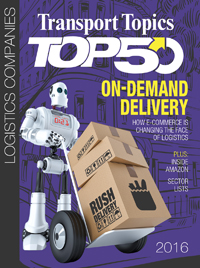An Insider's Look at the Hustle and Bustle of Amazon
 Click image to enlarge
Click image to enlarge
This story appears in the April 4 print edition of Transport Topics.
Amazon.com conjures up many images in the minds of consumers, shippers and investors.
For consumers, it’s an online candy store of goodies. For shippers, it’s a one-stop logistics supermarket. For investors, it’s the way of the future.
But what makes it all tick are the worker bees who can number in excess of 300,000 during the peak of the Christmas shopping season. I should know, because I was once one of them.
In approaching the Amazon fulfillment center in Middletown, Delaware, the first thing that strikes is the enormity of the building. Though not as huge as the company’s 28-football-fields-long facility in Phoenix, it is impressive nonetheless.
In Delaware, the 800,000-square-foot Amazon center contains hundreds of thousands of items from digital cameras to board games to books to coffee makers to laundry detergent to candy. There are at least 50 regional fulfillment centers and about 20 smaller sorting centers across the United States alone.
When you walk through the glass doors and scan yourself through the security turnstile, you are quickly swallowed up in a huge space whose initial calmness belies the hectic activities going on farther into the interior.
At the Middletown facility, at least 2,000 workers work around the clock to pick merchandise off stacks of shelves that rise more than three stories, while sorters are constantly restocking items to keep the cycle going smoothly.
On the shelves, you see a wide assortment of products — kids games and beads alongside kitchenware — as if a child had quickly cleaned up his room by putting items anywhere they fit.
But there is logic to this seemingly random placement of goods.
Pickers armed with a scanner and cart are guided by electronic markers to the items needed to fill an order. Workers have a certain amount of time, say two minutes, to get to the item and scan its bar code to signal it has been retrieved. Once all the items have been gathered, the bar code on the collection bin is scanned and it is placed on a conveyor belt and moved to a packing area where the merchandise is boxed for shipping.
I worked in the Make On Demand (MOD) department, where crews produced anywhere from 3,000 to 15,000 paperback books during each shift. The number depended greatly on whether the four main binding machines were cooperating and running smoothly.
It was grueling work that required you to be on your feet for nine hours during the 10-hour shift, with two 15-minute breaks and one 30-minute break.
In operating and expanding MOD units to other locations, Amazon seemed to be proving people who say “print is dead” wrong.
Banks of copying machines spewed hundreds of stacks of paper per hour. On an average shift, it was not uncommon to go through as many as eight pallets of paper. The paper ranged up to 18 by 24 inches and was fed into 14 black-and-white printing machines that were running simultaneously.
Next came the cutting crew, which programmed the blade for the incoming paper size and diced up the stacks, producing one complete book every three minutes. The volumes then move down to get their respective cover and then on the binders. Afterward, the finished books go through a quality inspection before they are injected into the shipping process.
The entire printing procedure mirrors the well-greased wheels that are turning outside the MOD area and illustrates why Amazon likely will be a growing force in the logistics and distribution field.
Doug Scott is a former Transport Topics editor who worked at Amazon from October 2014 to April 2015.


